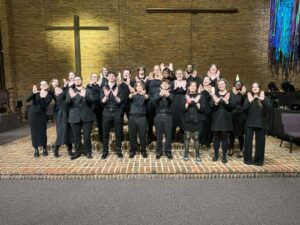Trick or treat? Treats? Well, actually, necessities. This month while millions of Americans have been gathering costumes and an estimated 600 million pounds of candy has been sold, a group of Wittenberg students and many community members, under the direction of Dr. Rosenberg, spent their Saturday packaging 60,000 nutritious meals which are bound for the country of Lesotho in Africa.
The Lesotho Nutrition Initiative (LNI) crew made great use of organization and enthusiasm to keep over one-hundred people moving in an assembly line like fashion, which might make Henry Ford envious. Every few minutes packaged meals were rolling off the assembly lines, boxed and loaded onto a commercial truck. There was even a bit of Halloween candy in the hallway for the troops to enjoy while being briefed on their 1:00-3:00 and 3:30-5:30 p.m. missions in the Shouvlin Center.
“I enjoy it, I love this team work, community service is so meaningful,” Erica Han, a Fulbright student from Taiwan, said.
Everyone was busy with various duties, including Paul Harrison, an Air Force retiree and father of two Witt alum. This Witt dad handled the logistical duties, including assisting with loading and transporting the 60,000 meals to the next stop for a short stay in a local warehouse with space donated by a local Rotary Club member. From there the meals travel to an eastern seaport, then on to an 8,000+ mile journey by ship to South Africa, and finally, a 300 mile road trip to the double landlocked mountainous Kingdom of Lesotho.
Why all the effort? Lesotho is one of the poorest countries with median monthly incomes of approximately $245. With a population of about two million, Lesotho has approximately 360,000 orphans and an HIV rate of 24%.
60,000 meals will feed 2,000 families for an entire month. Malnutrition with 1-5 year olds is especially of great concern in Lesotho. The world needs to take note.
“[It was] great to see so many students from different areas of campus; [different] majors and interests outside of academics involved,” President Frandsen said.
The end of the event saw the crews sharp direction and organization continue with an efficient and well coordinated cleanup and break down of equipment and remaining supplies. In a time span of approximately 35 minutes the large dual rooms went from a buzzing factory like setting, held together with leadership and enthusiasm, to a quiet and clean empty space made ready for its next event.
“[I am] hoping to return to the next event and travel to Lesotho next summer,” Taylor Barnisel, ‘21, said.
The U.S. has a long history of helping others at home and abroad. The greatest earliest effort being the Commission for Relief in Belgium, headed by a young, Herbert Hoover. From 1914-19 the United States arranged to feed eight million people in Belgium and Northern France during and just after WWI. Not long after, we did this again in the USSR for millions (1921-23). A century later Lesotho is now having American meals brought to them. We can do more. Helping others who can’t help themselves is in our DNA.







